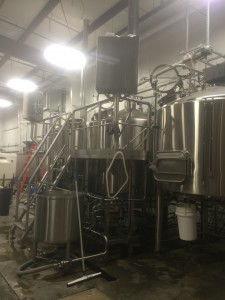
Beer and college are practically symbiotic # you can’t have one without the other.
The long-standing relationship reached a new level in November 2013 when 3 Daughters Brewing, a new brewery at 222 22nd St. S in the Midtown area, partnered with USF St. Petersburg to give biology students college credit for brewing beer.
The internship gives students the opportunity to apply their knowledge of science in a real-life situation.
“Chemistry and microbiology are very important to the brewing process,” said Jessy Weber, 21, a senior biology major.
Weber, one of the program’s first three interns, helped develop the lab, which is in the heart of the brewery. She ordered equipment and started setting up the lab before the brewery even opened.
The lab is “something most breweries don’t have,” said Tim Dominick, the tasting room manager.
Interns who work in the lab are responsible for one of the most important parts of the brewing process.
“PH, alcohol by volume, international bitterness units, and standard reference method color are the main chemistry aspects of beer we test in the lab,” said Weber. The standard reference method is what brewers use to give beer a specific color.
All the factors have to be consistent to sell beer, according to Weber. Interns also test yeast in the beer samples.
Yeast is the most important element of beer, according to Dominick. It is a single-celled organism that turns sugar into alcohol and carbon dioxide in the fermentation stage.
“We perform yeast cell counts on a regular basis to quantify the concentration of the yeast and how much we should be putting in the next batch of beer,” said Weber.
They also make something called an “agar plate,” a petri dish that contains a growth medium used to culture microorganisms. They do this to test the amount of bacteria in the beer, Weber said. If there is too much, the beer can turn sour.
All of these tests are vital to brewing. Interns who assist in these processes learn that biology isn’t just for pre-med students anymore.
“I never considered the science behind beer,” said Weber. “Biology majors are expected to go to med school or become marine biologists.”
Weber is now an employee. She occasionally helps out in the lab, but for the most part she works in the tasting room and gives tours of the lab and brew house.
The lab isn’t the only part in the brewing process. In fact, it’s a tedious task to brew the proper batch. It takes time and effort and cleaning – a lot of cleaning.
“Everybody thinks brewing beer is glamorous,” said Dominick, “but you spend more time doing paperwork and cleaning.”
It’s a long process, Dominick said. A batch of beer that takes three and a half hours to brew will end up taking eight hours because they’ll spend four and a half to five hours cleaning.
“It can’t be cleaned enough,” he said.
They pay close attention because even the smallest amount of dust can change the flavor of a batch entirely.
The idea for the brewery came from Mike Harting, the owner, and Ty Weaver, the head brewer, Dominick said. Harting once managed Bella Brava, a thriving restaurant in downtown St. Petersburg where Weaver was head chef.
Weaver wanted to create his own brews to expand the menu, and when they put the beer on tap they found that the craft brew accounted for about 40 percent of all beer sales.
Weaver and Harting went back and forth on the idea before opening 3 Daughters last December. The brewery celebrated its one-year anniversary with the release of a few new beers and a party on Dec. 12.
Want to know more? The brewery’s website is at 3dbrewing.com


